Referral marketing is one of the most powerful processes in your marketing toolkit. Referred customers are four times more likely to buy products than net new leads. Plus, referred customers have a lifetime value (LTV) that’s 16% higher than new leads and have a 37% higher retention rate. With a referral loop in place-the cycle of referring and onboarding new customers-you can harness this power to grow your customer base and boost revenue.
But what do you do if your program’s stale? Customers aren’t as excited about it anymore and don’t share referrals as much as they used to. Instead of firing up yet another email campaign or increasing reward amounts in the hopes of getting customers engaged again, get creative with the program’s structure.
We looked at 12 companies with ecommerce referral programs to find out what they do differently to make their programs engaging.
1. Athleta encourages real-life experiences
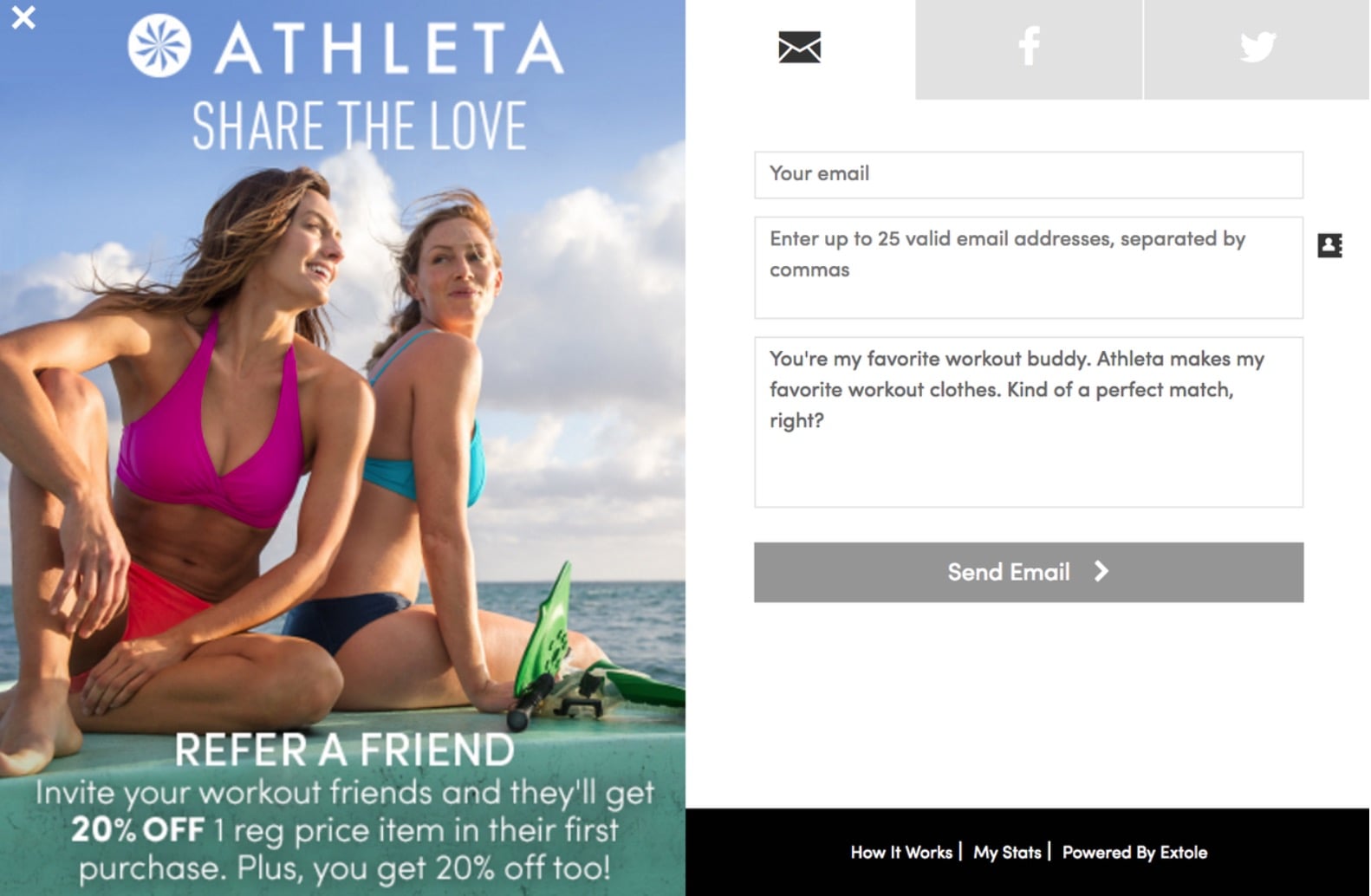
Athleta, an activewear brand for women and girls, is committed to promoting the benefits of health and wellness among its community. Their referral program stays true to this mission by inviting customers to share referrals with their workout friends.
Instead of just following the typical referral program structure of “Do X, Get Y,” the Athleta example above goes beyond and encourages customers to refer people who work out. The pre-populated message reads, “You’re my favorite workout buddy. Athleta makes my favorite workout clothes. Kind of a perfect match, right?” Both the customer and the referred friend get 20% off one regularly priced item.
Incorporating their business mission into the program works because it keeps Athleta’s message of creating positive, motivating, and memorable real-life experiences front and center. Customers who love and trust the brand buy into the program because it fits their beliefs and lifestyle. Referrals happen naturally because people are asked to do something they’d likely do anyway: workout with a friend.
Revitalize your stale program by connecting your company mission to an offer. Your loyal customers likely share your beliefs, so use them to help attract more like-minded customers. 90% of people trust the opinions of friends, so use this to your advantage. New customers who buy into your mission are likely to also love the product and stay loyal for years to come-raising revenue over time.
2. Ulta targets its most loyal customers
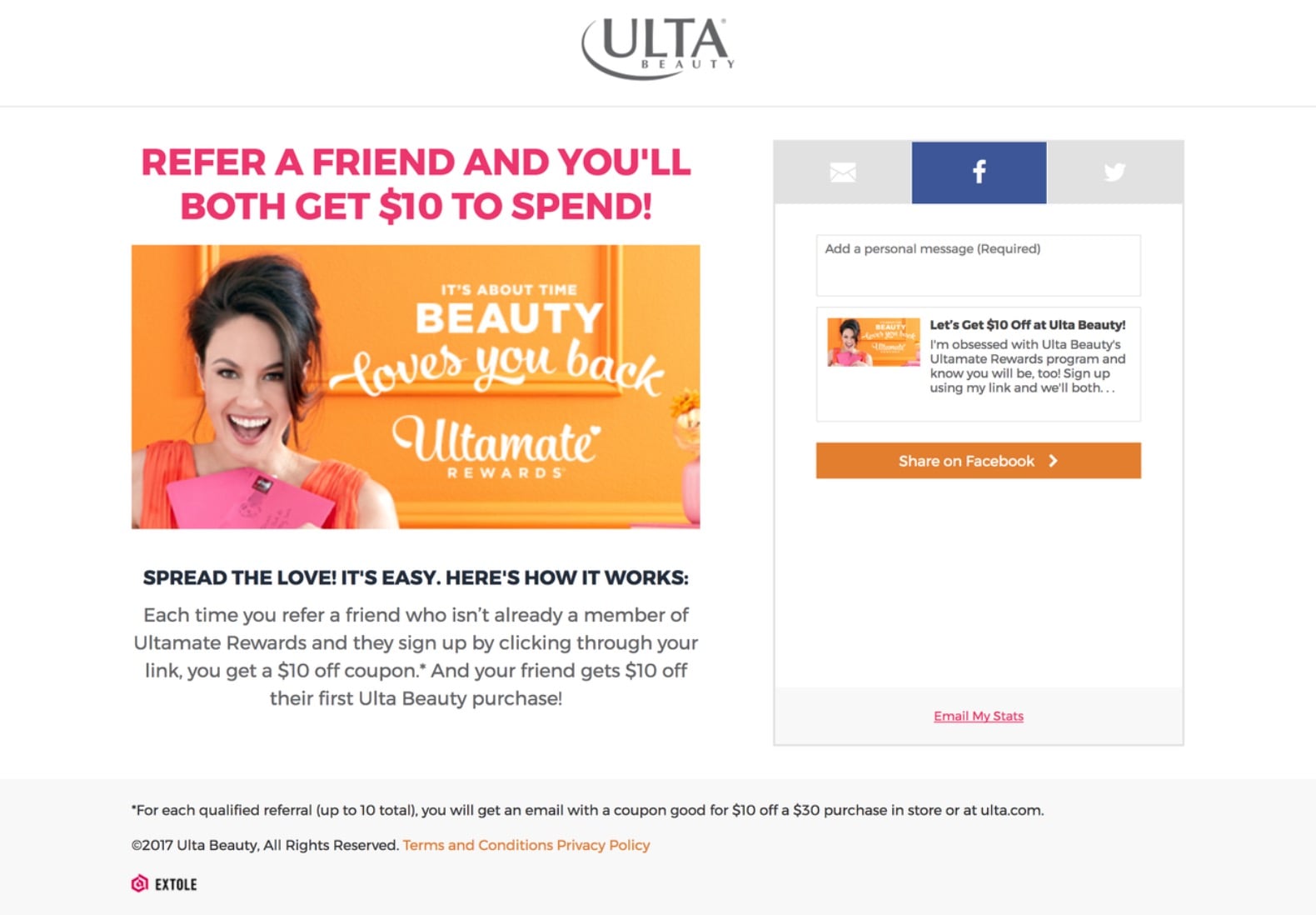
Ulta Beauty, a cosmetics and fragrance retail, uses referral marketing to grow their rewards program membership-not its general customer base. When an existing member refers a friend who then becomes a Ultamate Rewards member, the existing customer gets $10 off an order over $30 on any channel. Referred customers also get $10 off of their first order.
Speaking on why Ulta Beauty chose this approach, Eric Messerschmidt, senior vice president of marketing strategy, loyalty, and CRM for Ulta Beauty, explains that “consumers are increasingly looking for a shopping experience that is . . . personalized, so it’s important to offer a healthy and engaging rewards program.” He continues, “Not only does [the membership program] improve the overall experience for our valued guests, which creates more customers, but it gives us access to rich data from each guest transaction. We can use that data to target and communicate relevant offers that provide greater return on our marketing investment.”
Even if you don’t have a loyalty program, find a way to incentivize your most loyal customers so there’s an added bonus for sharing referrals. Find loyal customers by checking purchase frequency and order value. Segment customers, and focus on the segments with the highest frequency and order value.
Ulta Beauty had to adjust its reward program over time before it created Ultamate Rewards. You’ll have to do the same thing to revive a stale ecommerce referral program. Use your segmented customer list to test how different customers engage with the referral program. The more loyal customers you can target, the better, because it helps grow your customer base even more.
3. Hanna Andersson removes referral hurdles
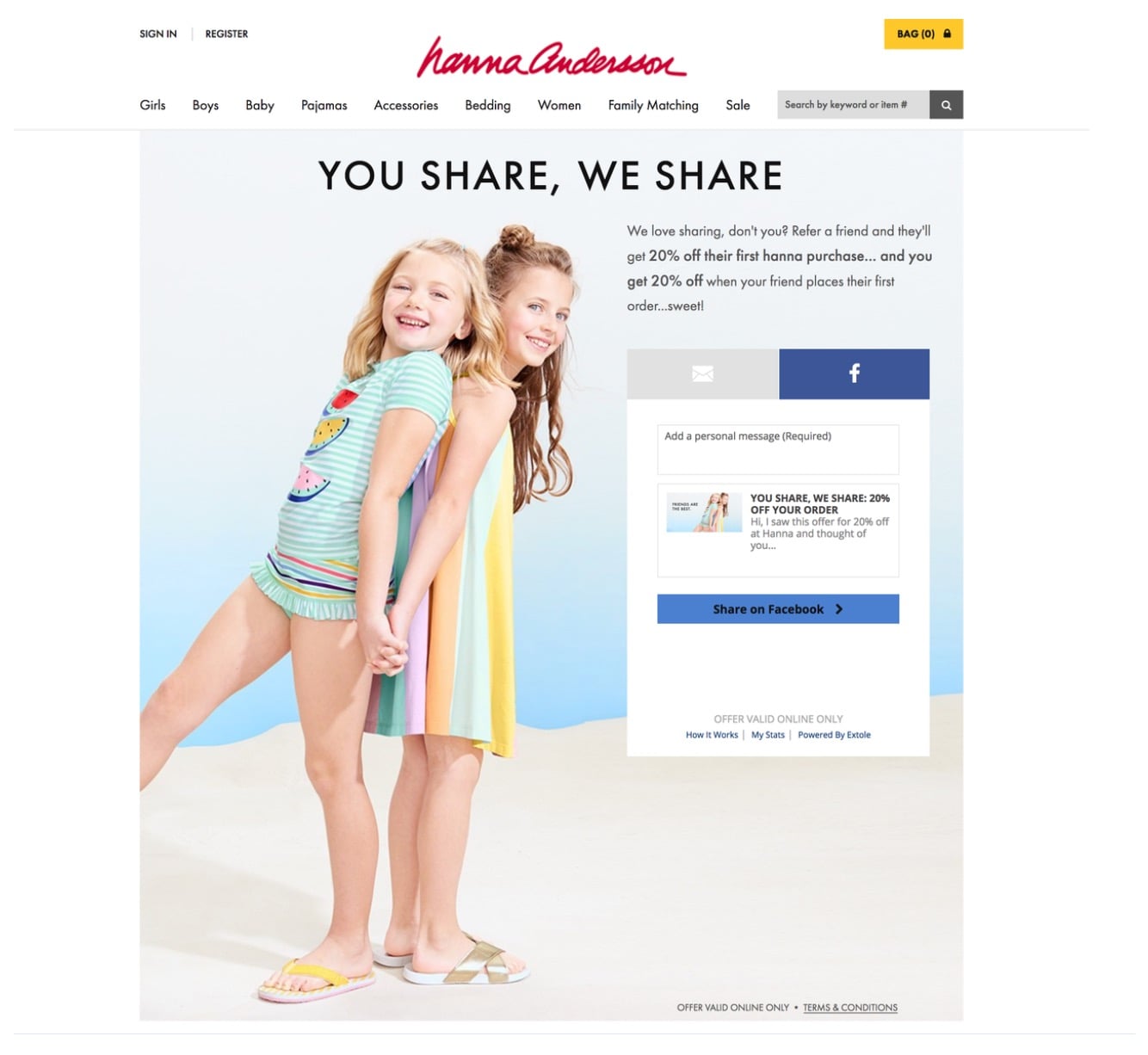
Children’s clothing retailer Hanna Andersson’s referral program gives referred customers 20% off of their first purchase and existing customers 20% off of their next purchase.
One reason referral programs go stale is because they’re hard to find online-so customers don’t use them. Hanna Andersson’s website is designed to keep the program top of mind by showing the program in multiple places-like the top of the home page and the footer of every web page. Making the referral program more visible minimizes friction so customers don’t have to search the website to find the program.
Hanna Andersson also lets customers refer a friend without logging in first. This small change helped Hanna Anderson reach 25% of their annual acquisition goal in just two months.
The first step in getting more customers to use your ecommerce referral program is to make it easy to participate. Use a tool like Google Analytics to find out where customers drop off before completing the referral. Fix the issue-for example, remove the login requirement, like Hanna Andersson did-and test how many customers engage.
4. Amerisleep keeps customer experience in mind
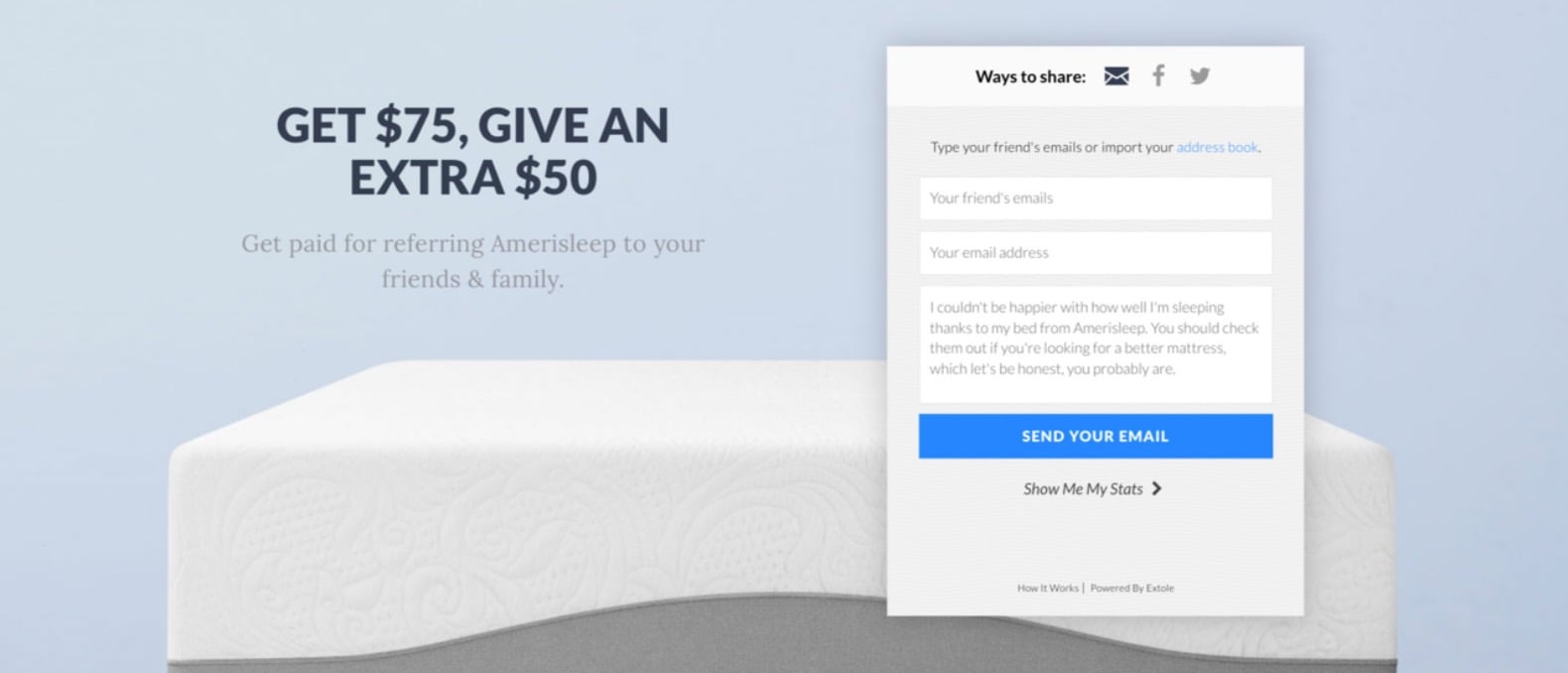
Amerisleep offers a clear-cut referral program: customers get $75 when their referrals use a $50 credit toward a mattress. Amerisleep makes customer participation frictionless by pre-populating the referral message box.
There’s no pressure on the customer to come up with a message-Amerisleep does it for them. All customers have to do is click “send.” Plus, the message sounds personal and not “sales-y”; overly promotional messages from companies turn off prospective ecommerce customers. The message includes a benefit-a good night’s sleep-and injects a little humor.
Amerisleep increased click-through rate (CTR) on its referral program by considering customer experience. To make it easy for your customers to engage with your ecommerce referral program, pre-populate the message box with a casual message, and include the customer’s email address.
5. Julep engages customers through multiple channels
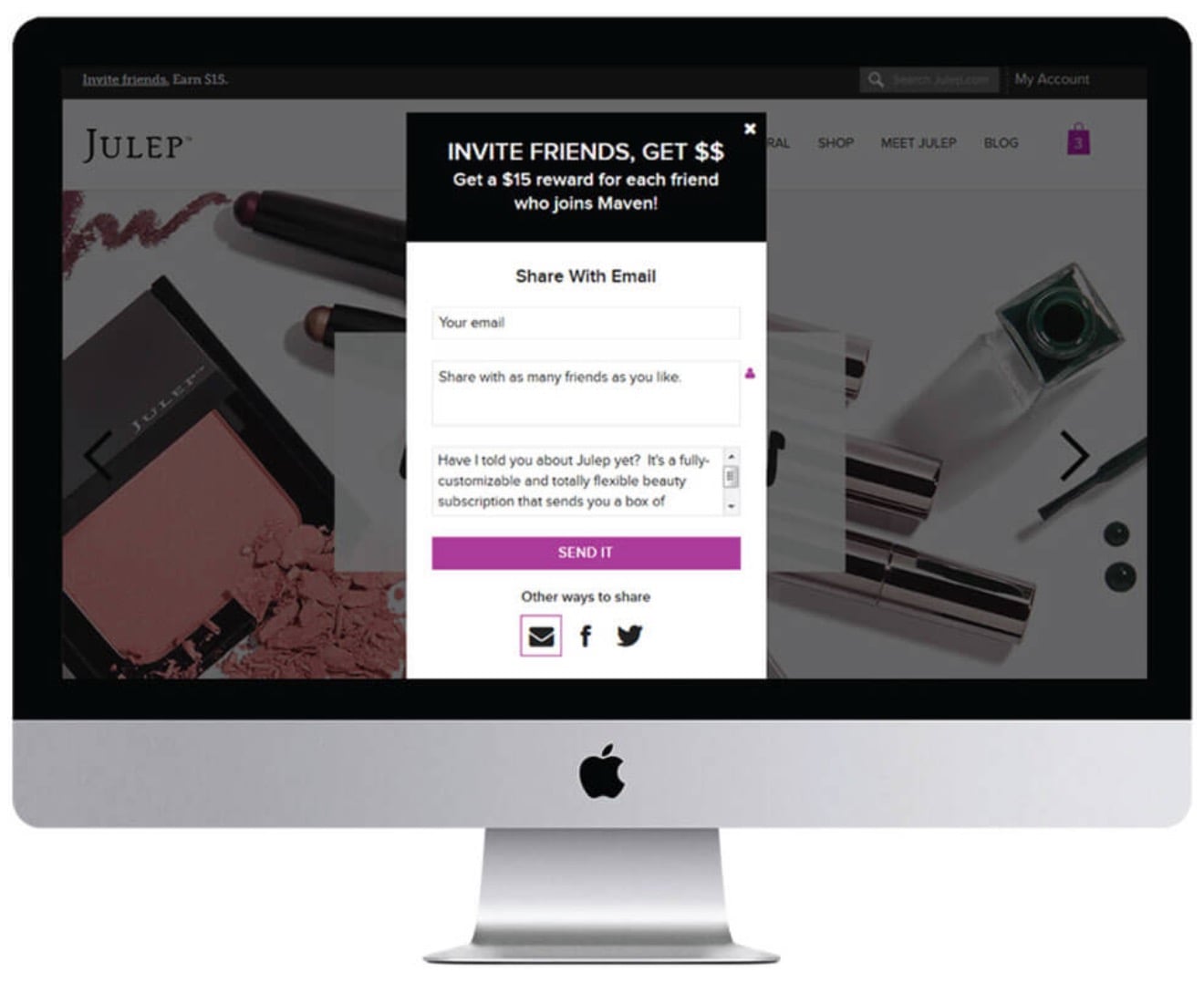
Customers get $15 for every referral they make for Julep’s Maven subscription box. The referral program lets customers share referrals across multiple channels, such as email, Facebook, and Twitter.
Giving customers options on where they share referrals helps increase engagement. If customers can share referrals through only one or two channels, then programs go stale if customers don’t normally use these channels. By giving customers a chance to share on different channels, there’s a better chance they’ll find a convenient platform. In fact, Julep gets five times the number of referrals during promotional campaigns with its omnichannel approach.
To figure out which channel options to offer, run a test referral program that includes different channel combinations. One might include email and social media, while another includes email and a personalized link customers text to friends. Include the top channels-the ones with the most customer CTRs-in your program.

Referral Marketing – The Best Practices You Need to Know
Written by veteran referral marketers, this guide will help you optimize your referral marketing program and supercharge growth.
Get the Guide6. Backcountry offers bulk invitations
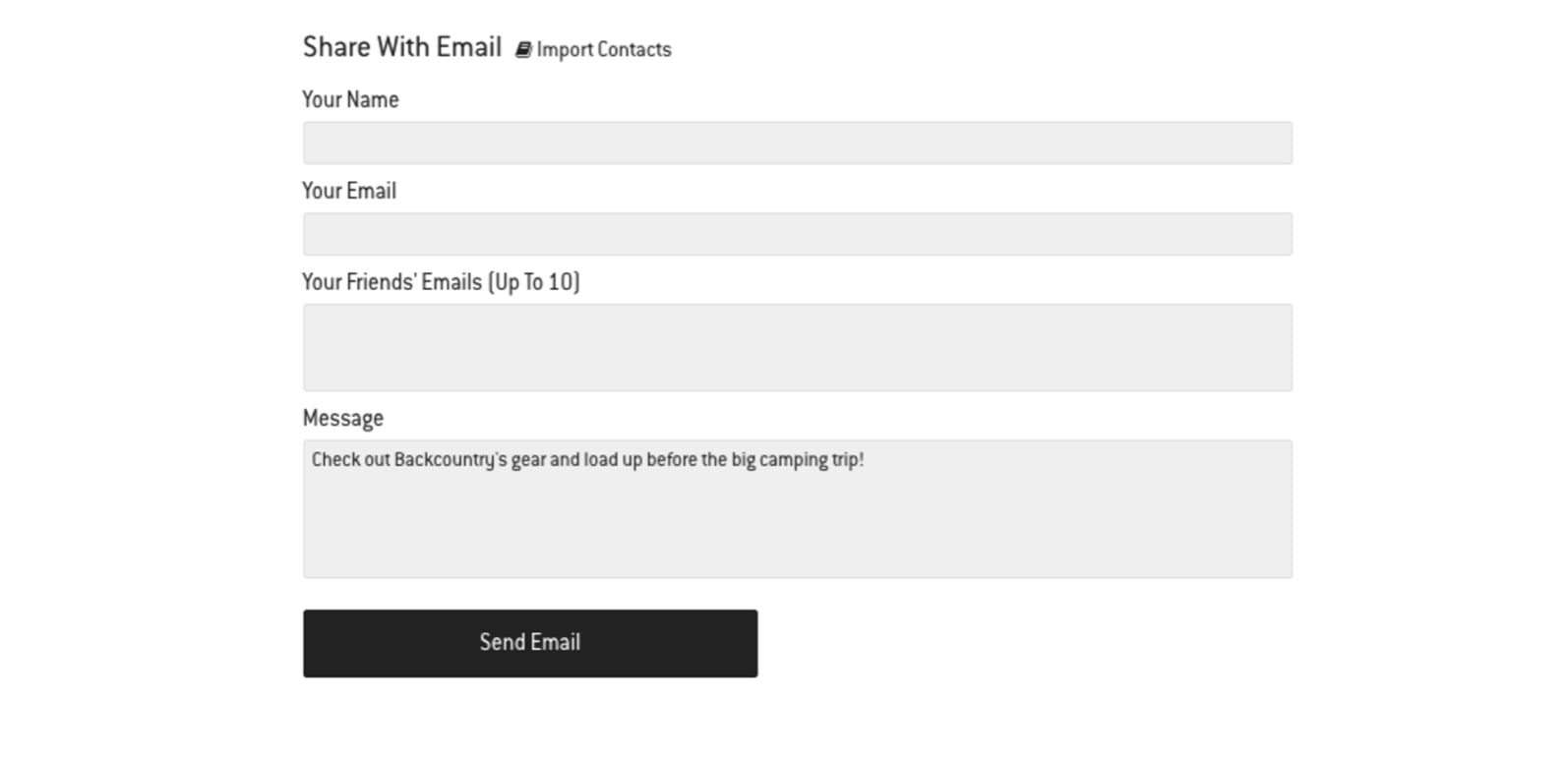
Backcountry is an outdoor clothing and gear retailer that uses a standard format for its referral program. Customers get a $10 credit when they refer a friend. Their referral gets $10 off their first purchase.
Where Backcountry’s program differs from many others on this list is the “import contacts” option at the top. Customers aren’t expected to remember their friends’ email addresses (hardly anyone does) or open their email contacts list in another app. Programs go stale when customers have too many steps to complete. They’ll put off referring for later but end up forgetting or putting it off even longer. The “import contact” option means that, with just a few clicks, customers share referrals.
Backcountry also lets customers enter up to 10 email addresses at once-customers don’t have to manually enter each email in a separate referral invitation. Again, customers save time by acting now instead of waiting for later. If you don’t already, upgrade to a referral marketing platform that lets you offer customers an import contacts function.
7. Seamless creates a sense of urgency
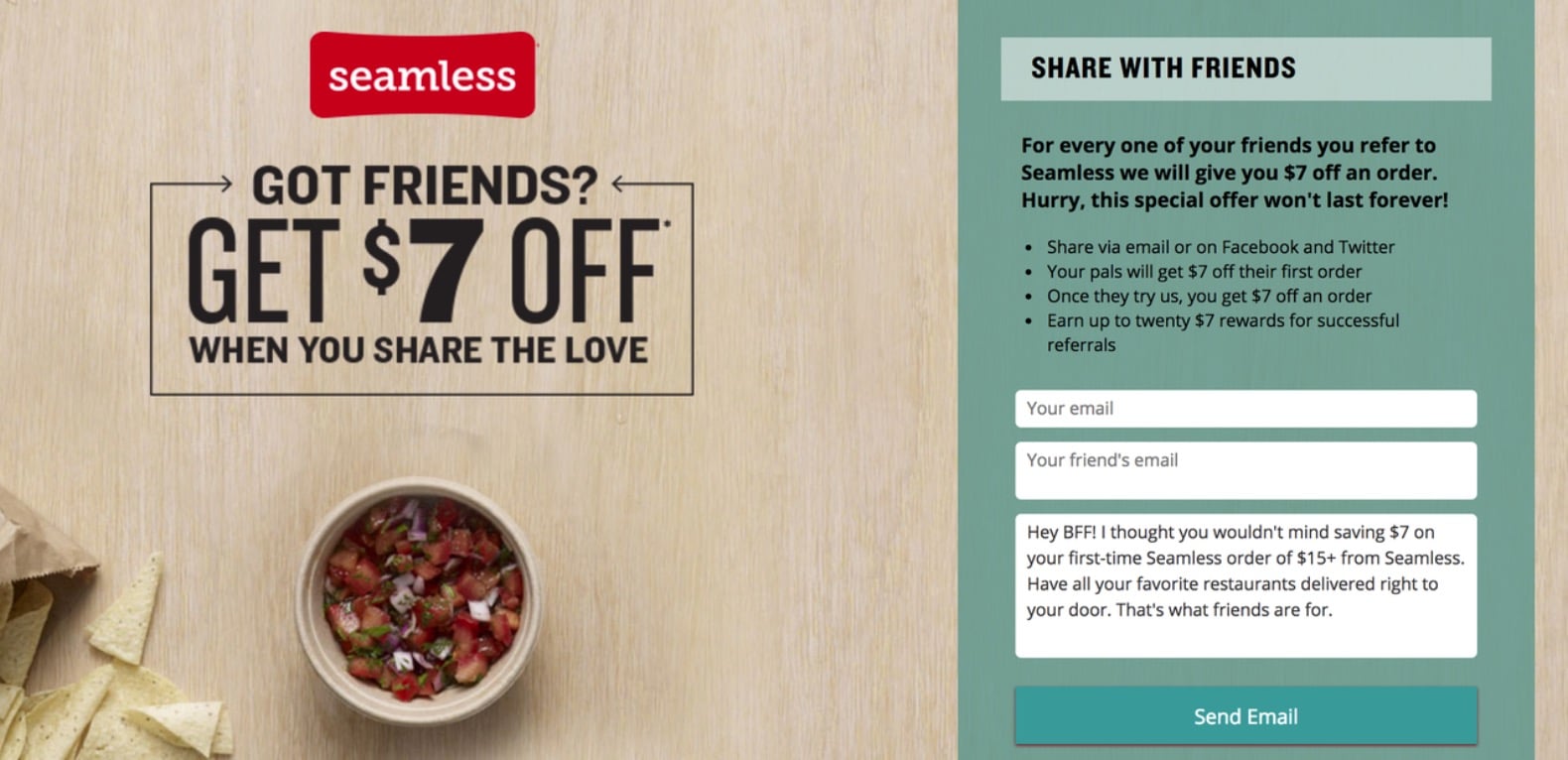
Seamless’s referral program includes a time limit. The offer reads, “For every one of your friends you refer to Seamless we will give you $7 off an order. Hurry, this special offer won’t last forever!“
The last sentence grabs customers’ attention because it adds a sense of urgency to the message: act now or you’ll miss out. The offer explains that customers can earn up to 20 $7 rewards for successful orders. That’s $140 customers can use toward orders at any restaurant they choose.
To add a sense of urgency to your ecommerce referral program, keep the offer deadline vague, as Seamless does. Or add a deadline, and show customers how much they can earn if they act quickly rather than wait. Show an “after deadline” discount if customers wait-which is lower than the premium offer-to motivate customers to act.
8. Rover builds trust for its services
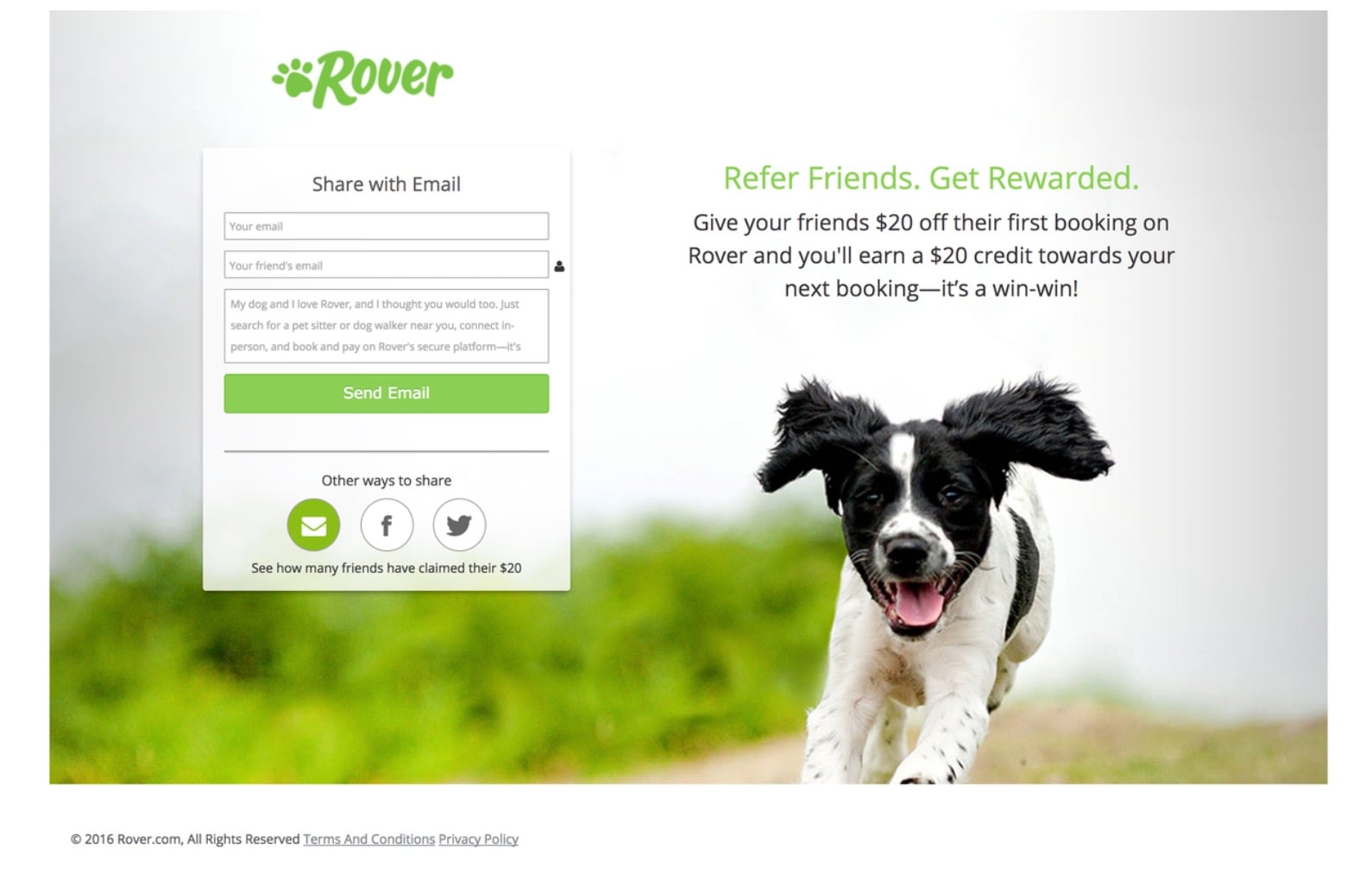
Rover, a pet-care service operator, offers a referral program that gives customers $20 credits toward future bookings, and referrals $20 off their first booking.
Unlike the examples we’ve covered so far, Rover doesn’t have a tangible product. Customer referrals are based on their experience with the service. As a result, Rover uses its referral program to help build trust with new users and get their buy-in. The pre-populated message mentions how the owner (and their pet!) enjoyed the service-which is important to pet owners when choosing a new service.
The message reads, “My dog and I love Rover, and I thought you would too. Just search for a pet sitter or dog walker near you, connect in-person, and book and pay on Rover’s secure platform.“
Using customer experience to attract referrals helps tell a story, almost like a testimonial, and caters to what’s most important to your audience. In Rover’s case, their audience wants to find trustworthy services for their pet.
To get customers to start sharing your referral program again, remind them about their own experience. Approach loyal customers, or reach out to customers who’ve recently had a positive customer service experience. These groups are happy about their experiences and are most likely to share referrals.
9. Vistaprint uses Twitter to reach a larger audience
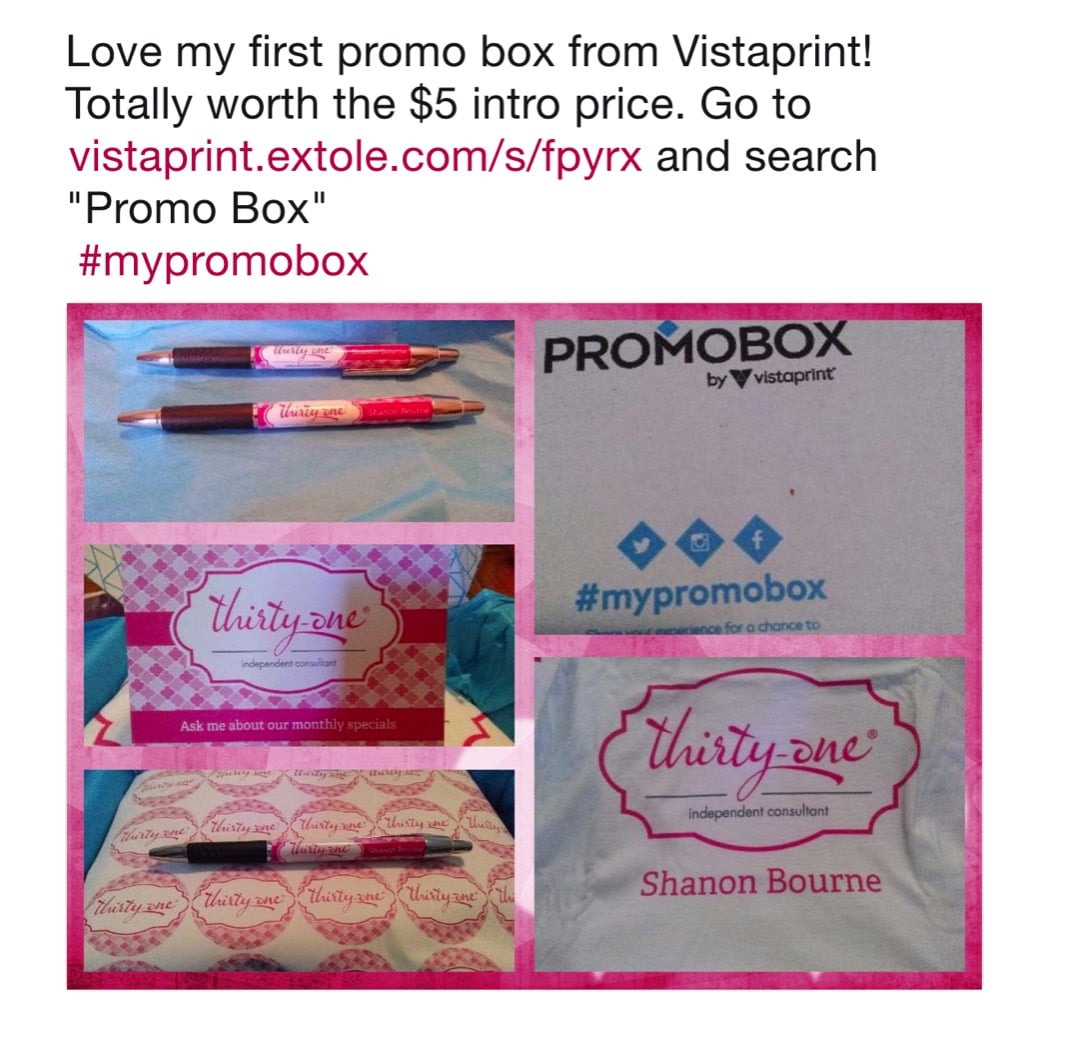
Vistaprint’s referral program is unique compared with others on this list. Vistaprint encourages customers to use Twitter to share their experience using the Promo Box service-a monthly subscription box that includes customized products. Customers share a link that leads to a branded landing page with more product information. The following image is an example of Promo Box contents and how customers share their experience online.
Instead of directly asking customers to share referrals, Vistaprint asks customers to share their experience for a chance to be a featured business. Using the hashtag #mypromobox, customers generate interest for Vistaprint from other business owners.
This approach works because Vistaprint relies on user-generated content (UGC) to grow its customer base. Anyone who sees posts like these-they either follow the user who posted or follow the hashtag-gets exposed to the program.
If engagement with your referral program has dropped, then consider giving customers a personal code to share on social media and ask them to post pictures of themselves using your products. UGC campaigns work because they feel natural and authentic-you don’t come across as another business trying to sell something. Customers appreciate UGC campaigns because they get to be in the spotlight and share about their expertise and experience with your products.
10. Vera Bradley rehashes program benefits
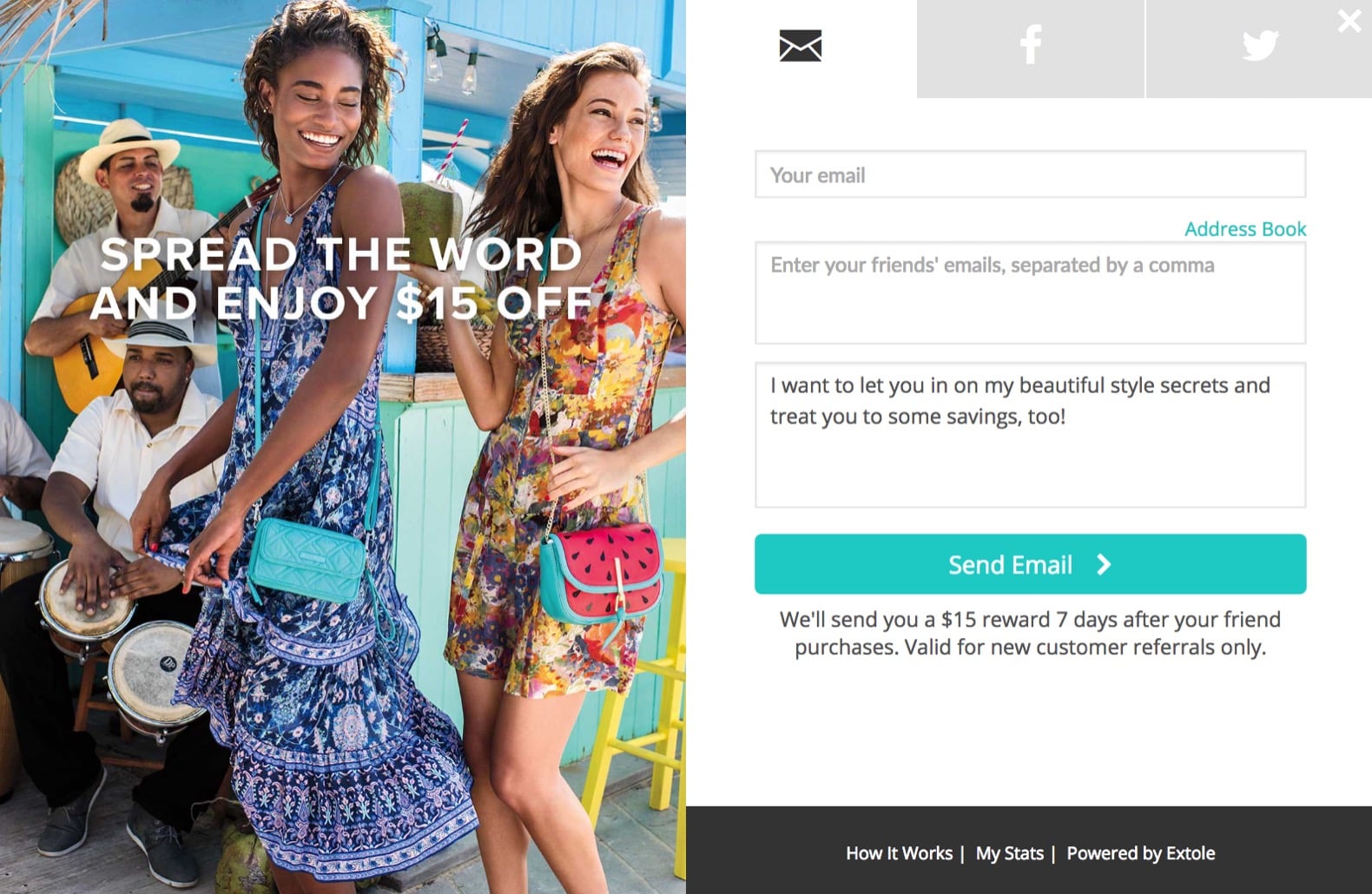
Vera Bradley is a handbag and luggage company that gives customers $15 off of their next purchase when they refer a friend.
Vera Bradley’s products are fun and flirty. A quick browse through their website reveals lifestyle pictures of cheerful people wearing purses and other types of bags in everyday situations-like going to the gym or hanging out with friends.
The referral program continues the theme of how easy it is to fit the unique products into day-to-day life. The pre-populated message also creates a sense of being a part of something special. The caption reads, “I want to let you in on my beautiful style secrets and treat you to some savings, too!” Who wouldn’t want to be a part of something exclusive?
To get customers excited and motivated again, remind them of what they get out of referring. You’ll notice that the caption at the bottom of Vera Bradley’s referral only references what customers get-a $15 reward; the referred customer reward isn’t the focus here. Some purses and accessories sell for as little as $6, so customers can get one or more “free” products with their referral reward.
11. Talbots offers a double reward
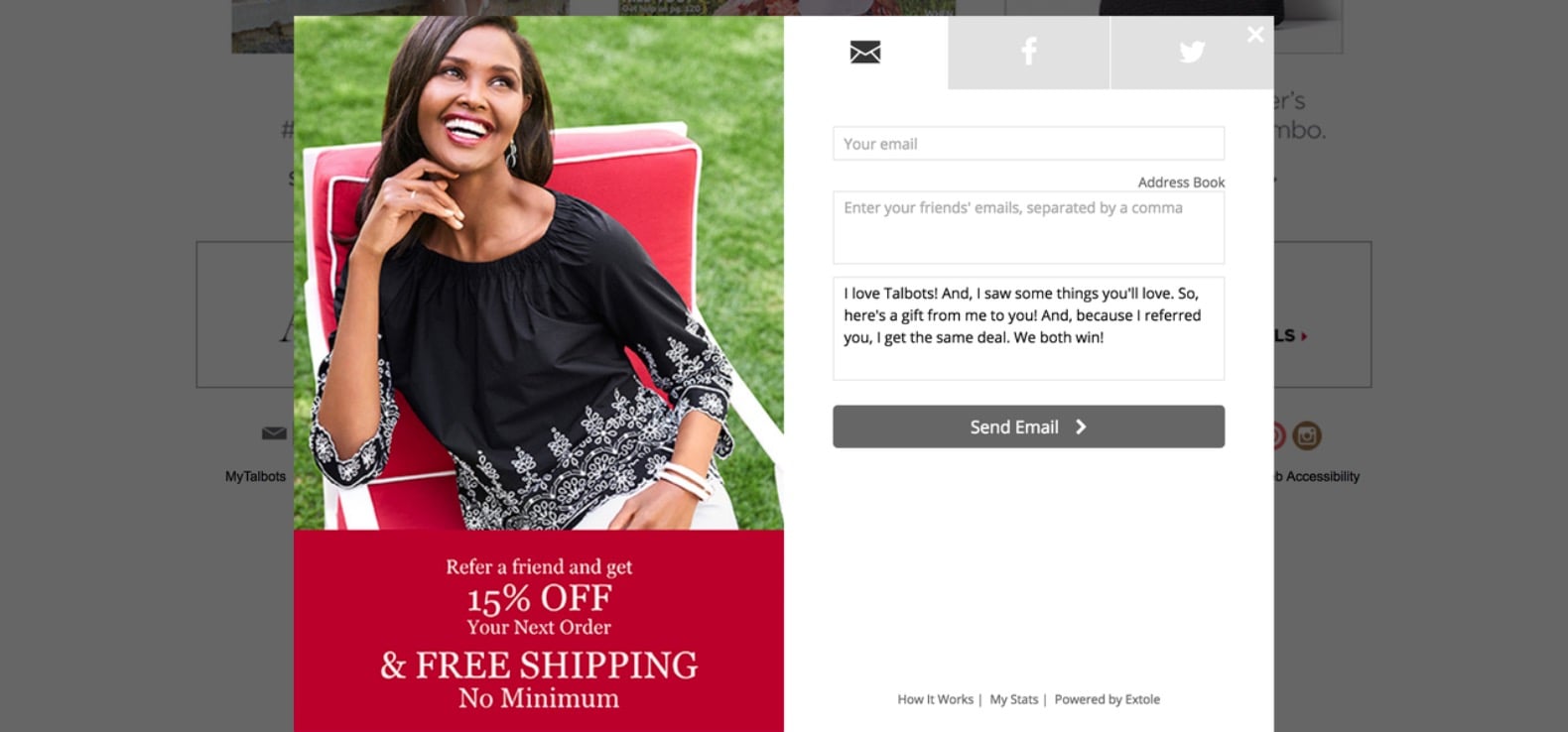
Talbots is another clothing retailer. Its referral program emphasizes the benefits customers and their referrals receive. Both customers and their referrals get 15% off a future purchase, and free shipping (no minimum).
Many of the examples we’ve discussed so far focus on mutual benefits. The reason this approach works is that it helps revive interest in your referral program by positioning customers as a source of information for their friends. People generally want to feel like their suggestions matter and help the people around them. The message in this example reads, “I love Talbots! And I saw some things you’ll love. So, here’s a gift from me to you! And, because I referred you, I get the same deal. We both win!“
Talbots’s offer also gets customers to take action because it includes a “double offer”-it’s the only company on our list that offers this. Customers not only get 15% off their next order but also get free shipping with no minimum purchase. An offer like this is enough to get a customer who is on the fence about a purchase to take a leap, refer, and buy because they’ve got nothing to lose.
Send your customers a survey to find out what benefits they’d like to receive. Test out different options to see which ones have the most engagement. Refresh your referral program accordingly. Make sure that the benefits you do offer don’t negatively affect your sales.
12. Advance Auto Parts uses gift cards as an incentive
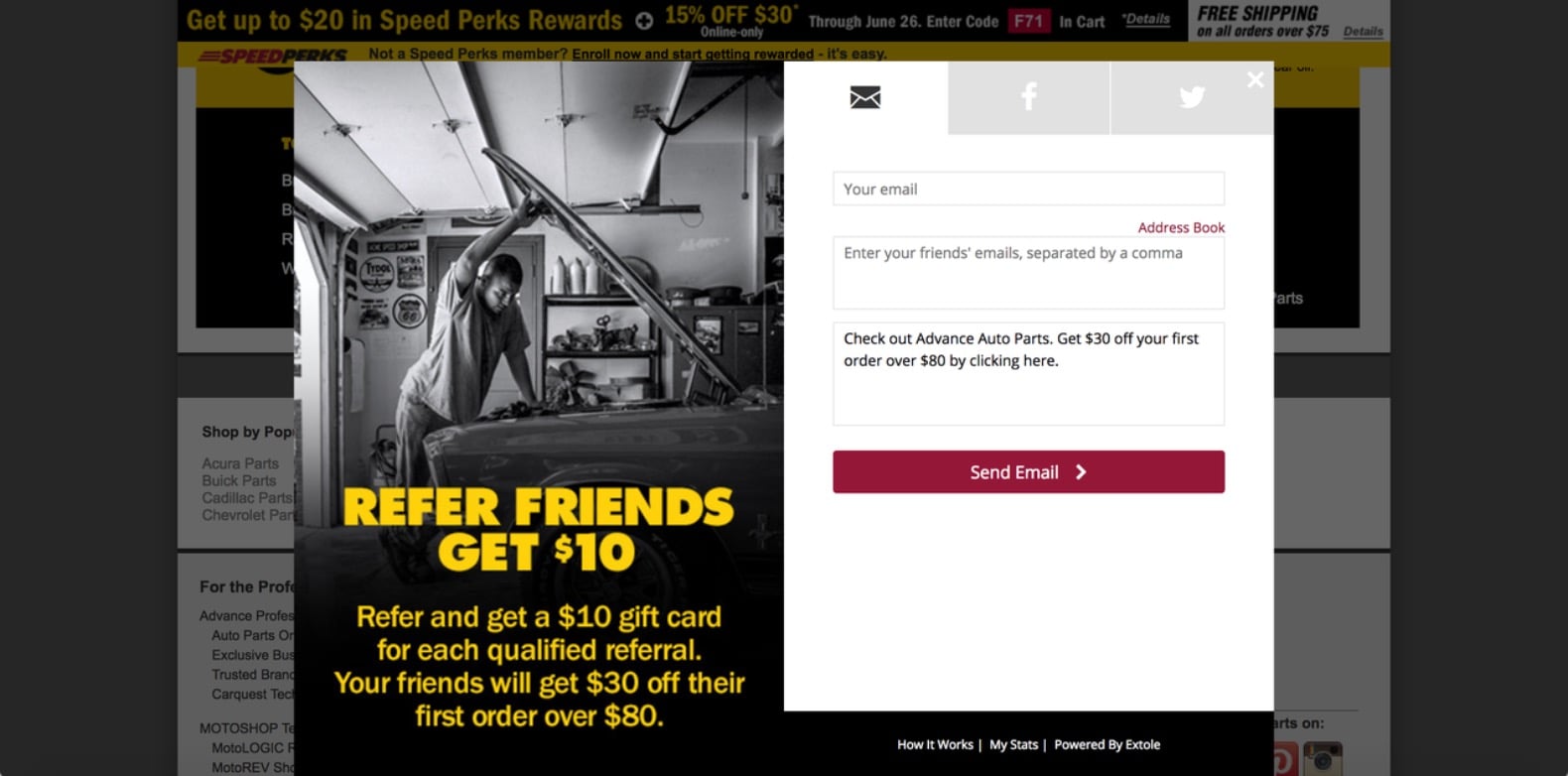
Advance Auto Parts, an aftermarket parts supplier, gives customers a unique value proposition: instead of offering a credit or a discount toward, a future purchase, Advance Auto Parts gives customers a $10 gift card. Referrals get $30 off their first order over $80.
In addition to the referral offer, Advance Auto Parts also added details to the store’s home page, which increased online referrals. When customers land on the home page, they’re also reminded of the offer. In fact, Advance Auto Parts analyzed its customer data and found that many of its customers are acquired through referrals. It literally pays to keep the program top of mind.
Consider adding a section to your home page that introduces the referral program. Advance Auto Parts has a link with bold, red text announcing special offers. It’s eye-catching and encourages customers to click the link to learn more.
Create ecommerce referral programs to fit your needs
As you can see, there are lots of ways to improve your referral program to make it more attractive and compelling.
Don’t blow up your ecommerce referral program just yet though. Instead, experiment with different approaches to find the one that gets you more customer engagement. Depending on what matters to your customers-recognition or deep discounts-adjust your program accordingly.
It might be that the only thing your program needs is to do a better job of catering to customer needs. The typical referral program formula might work for some, but that doesn’t mean you have to do the same thing.



